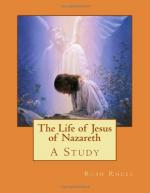35. A word may be due to two other claimants to recognition as original records from the life of Jesus. One class is represented by that word of the Lord which Paul quoted to the Ephesian elders at Miletus (Acts xx. 35). Scattered here and there in writings of the apostolic and succeeding ages are other sayings attributed to Jesus which cannot be found in our gospels. A few of these so-called Agrapha seem worthy of him, and are recognized as probably genuine. The most important of them is the story of the woman taken in adultery (John vii. 53 to viii. 11), which, though not a part of the gospel of John, doubtless gives a true incident from Jesus’ life. They represent the “many other” things which John and the other gospels have omitted, but their small number proves that our gospels have preserved for us practically all that was known of Jesus after the first witnesses fell asleep. It is certainly surprising that so little exists to supplement the story of the gospels, for they are manifestly fragmentary, and leave much of Jesus’ public life without any record. The other class of claimants is of a quite different character,—the so-called Apocryphal Gospels. These consist chiefly of legends connected with the birth and early years of Jesus, and with his death and resurrection. They are for the most part crude tales that have entirely mistaken the real character of him whom they seek to exalt, and need only to be read to be rejected.
III
The Harmony of the Gospels
36. The church early appreciated the value and the difficulty of having four different pictures of the life and teachings of the Lord. Irenaeus at the close of the second century felt it to be as essential that there should be four gospels as that there should be “four zones of the world, four principal winds, and four faces of the cherubim” (Against Heresies III. ii. 8).
37. Before Irenaeus, however, another had sought to obviate the difficulty of having four records which seem at some points to disagree, by making a combination of the gospels, to which he gave the title “Diatessaron.” Tatian, the author of this work, was converted from paganism about 152 A.D., and prepared his unified gospel, probably for the use of the Syrian churches, sometime after 172. His work is one of the treasures of the early Christian literature recovered for us within the last quarter-century. It seems to have won great popularity in the Syrian churches, having practically displaced the canonical gospels for nearly three centuries, when, owing to its supposed heretical tendency, it was suppressed by the determined effort of the church authorities. It is a continuous record of Jesus’ ministry, beginning with the first six verses of the Gospel of John, passing then to the early chapters of Luke. It closes with an account of the resurrection interwoven from all four gospels, concluding with John xxi. 25. The arrangement follows generally the order of Matthew, additional matter from the other gospels being inserted at places which approved themselves to Tatian’s judgment. Some portions—in particular the genealogies of Jesus—were omitted altogether, in accordance with views held by the compiler.




